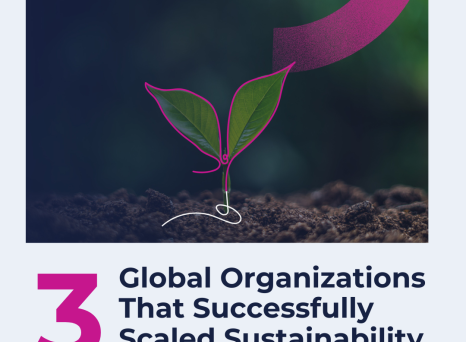Our latest research “Insights into Sustainable Project Management” study (a free download) has unearthed a critical issue: a stark disconnect plagues many organiz
Our latest research “Insights into Sustainable Project Management” study (a free download) has unearthed a critical issue: a stark disconnect plagues many organizations, where lofty sustainability strategies fail to translate into tangible, effective project delivery. Let’s dive deeper into this conundrum, offering actionable insights and robust steps for organizations eager to sync their aspirations with real-world applications.
Understanding the Gap
The front lines of our study spotlight an escalating awareness of sustainability as a strategic imperative, spurred by the intensifying impacts of climate change on business operations. Despite widespread recognition of the need for change, a significant gap lingers—strategic commitments to sustainability are frequently declared but seldom fully integrated at the operational level.
In our study, 49% have recognized the importance of embedding sustainability into their strategic frameworks. This signifies a growing awareness of and commitment to addressing environmental, social, and governance (ESG) issues. Organizations with a defined sustainability strategy are better positioned to navigate the complexities of public and private sector operations more effectively, to respond to regulatory and market pressures, and to meet stakeholder expectations for sustainable practices.
At the same time, 68% do not have long-term sustainability goals that align with their project management practices. This means these organizations have not integrated sustainability into their core strategic and operational frameworks.
The Core Issue: Strategic vs. Operational Disconnect
One of the most critical challenges facing organizations today is the misalignment between lofty sustainability strategies and their actual implementation. This strategic vs. operational disconnect is not just a procedural gap; it’s a profound chasm that can hinder an organization’s sustainability goals and its credibility.
For example, consider the recent push towards electric vehicles (EVs) by major automotive manufacturers like Ford and General Motors. These companies have publicly committed to electrifying their fleets and achieving ambitious environmental targets within the next decade. Ford announced its plan to produce only electric vehicles in Europe by 2030 and aims for 40% of its global vehicle volume to be fully electric by then. Similarly, General Motors has pledged to stop selling gasoline-powered cars by 2035.
While these commitments are strategically sound and align with global sustainability goals, the operational reality presents a starkly different challenge. Transitioning to electric vehicles involves not just redesigning vehicles but also overhauling supply chains, establishing robust charging infrastructures, and navigating the complexities of battery production and raw material sourcing. For instance, the global shortage of semiconductors has already disrupted production schedules, and the scarcity of essential minerals for batteries like lithium and cobalt poses additional risks.
Another vivid example can be seen in the fashion industry, where brands like H&M and Zara have been vocal about their sustainability initiatives. They have launched clothing lines made from recycled materials and committed to reducing greenhouse gas emissions throughout their production processes. However, operationalizing these strategies effectively is a different ballgame. The fast fashion model inherently relies on rapid production cycles and high turnover, which can contradict the sustainability goals of reducing waste and promoting more sustainable consumption patterns. The backlash from environmental groups and the pressures from increasingly conscious consumers highlight the disconnect between their sustainable branding and the industry’s underlying operational practices.
These examples underscore a common theme: aligning strategic intentions with operational capabilities requires more than just setting targets. It involves a fundamental transformation in how the organizations operate daily. It requires innovations in technology, adjustments in supply chain logistics, investments in new capabilities, and often, a cultural shift towards sustainability within the organization.
Addressing these disconnects demands not only strategic vision but also a concrete plan for operational execution that considers the complexities of changing technologies, market dynamics, and regulatory environments. As these companies illustrate, without a clear operational path, even the most ambitious sustainability strategies can struggle to move beyond good intentions.
Practical Steps to Bridge the Gap
To forge a path over this divide, organizations might consider several strategic approaches:
- Define Clear Sustainability Objectives: Craft SMART goals that resonate with both strategic visions and concrete project outcomes.
- Integrate Sustainability into Every Project Phase: From kickoff to wrap-up, weave sustainability criteria throughout the project lifecycle. (You can read our P5 Standard for free and learn how to do this.)
- Boost Communication and Training: Ramp up training for project managers and teams, ensuring a unified understanding of sustainability targets. And yes, we know just where you can find such training.
- Implement Rigorous Sustainability Metrics: Leverage frameworks like the aforementioned P5 Standard and its 49 elements to track and refine sustainability measures.
- Conduct Regular Impact Assessments: Regular evaluations can ensure strategies are effectively implemented and pinpoint areas ripe for improvement.
- Engage All Stakeholders: From internal teams to suppliers and clients, inclusivity can enrich perspectives and boost strategy efficacy.
Case Study: Cisco Systems’ Sustainability Journey
During a recent chat with a project leader at Cisco Systems, concerns were raised about the scope of their NetZero goals. However, Cisco’s sustainability efforts extend beyond internal operations, encapsulating product innovation and comprehensive community engagement, as highlighted in their FY23 Purpose Report:
- ESG Focus Areas: Cisco aligns its strategies with global frameworks like GRI and SASB, ensuring focus on critical areas like climate change and social inclusion.
- Employee and Community Engagement: With initiatives like the 24 Green Team Networks and annual SustainX events, Cisco actively fosters an engaged, environmentally conscious workforce.
- Product Sustainability: From energy-efficient chips to sustainable infrastructure solutions, Cisco is leading the charge in reducing environmental impacts across its product lineup.
- Supply Chain and Emissions Reduction: Cisco is committed to a 30% reduction in supply chain and customer emissions by 2030, demanding similar commitments from its suppliers.
- Renewable Energy Initiatives: With 91% of its electricity sourced from renewable energies in FY23, Cisco is making significant strides towards its RE100 commitment.
- Water Stewardship and Waste Management: Cisco’s comprehensive approach includes water stewardship and aggressive waste reduction targets, enhancing sustainability throughout its operations.
A Strategic Imperative for Sustainability
Closing the gap between sustainability strategy and project execution is far more than a regulatory necessity—it’s a strategic imperative for resilience and long-term success. By deeply embedding sustainability into project management, organizations can boost their operational effectiveness and emerge as sustainability leaders.
Now more than ever, organizations must align their project management practices with their sustainability strategies to not just survive but thrive in our eco-conscious business landscape. By adopting the outlined strategies, organizations can drive sustainability, spark innovation, and also meet their disclosure requirements!




